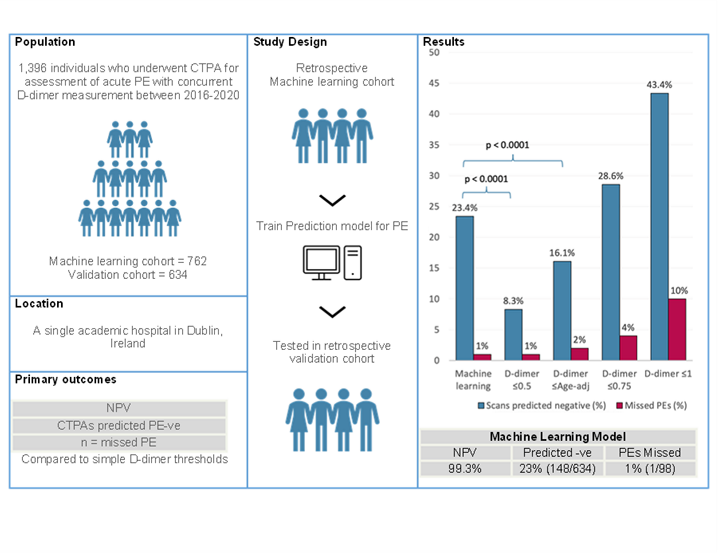Published today in European Respiratory Journal
(04 March 2022) A Study published today in the European Respiratory Journal (HERE) investigated if D-dimers (a fibrin degradation product or small protein fragment present in the blood after a blood clot is degraded by fibrinolysis) combined with clinical factors in a trained machine learning model, improves prediction of PE (Pulmonary Embolus) in moderate-risk patients who have a CT scan to detect PE. This single-centre study was conducted by the Department of Respiratory Medicine, St Vincent’s University Hospital (SVUH) D4.
Speaking about the context for the Study titled ‘Extended D-dimer Cut-offs and Machine Learning for Ruling-Out Pulmonary Embolism in individuals undergoing CTPA’, Dr Cormac McCarthy, Consultant Respiratory Physician, SVUH, Associate Professor, UCD School of Medicine and Senior Author said, ‘PE is a major cause of morbidity and mortality. CTPA (Computed Tomography Pulmonary Angiography) is considered the gold standard for diagnosing PE, but its use has quadrupled in the past two decades, and PE is still only detected in a minority of cases. Most importantly, CTPA contributes to potentially avoidable radiation exposure for patients. Identifying new ways to improve identification of which patients truly stand to benefit from CTPA would lead to better patient outcomes as well as improving resource utilisation.’
Study design
Speaking about the results of the Study, Dr Kathleen Curran, Assistant Professor, Diagnostic Imaging, UCD School of Medicine. Director, UCD Machine Learning in Medical Imaging Research Group and the Study’s Co-Author said, ‘These exploratory results demonstrate that, modern analytical methods combined with readily available clinical information can be used to improve patient care and healthcare efficiency in common, high-stakes areas such as the investigation and management of venous thromboembolism.’
The Study is the result of the growing research collaboration between the Respiratory Research Group and the Machine Learning Team at the UCD School of Medicine. This synergistic approach has result in a recent award of €550,000 from Enterprise Ireland for the project “RareLungAI -- Radiology Screening Solution”. Prof. Kathleen Curran and Prof. Cormac McCarthy are the Co-Leads on this initiative which will develop a cost-effective artificial intelligent (AI) tool, which will be embedded in existing radiology workflows, to screen chest CT scans for rare diffuse cystic lung disease (DLCD), and distinguish between DCLD, emphysema and “normal” lungs. This will ultimately result in earlier diagnosis of these rare diseases and improve patient outcome and quality of life.
See more here on UCD Machine Learning in Medical Imaging and Diagnostics
Appendix 1
